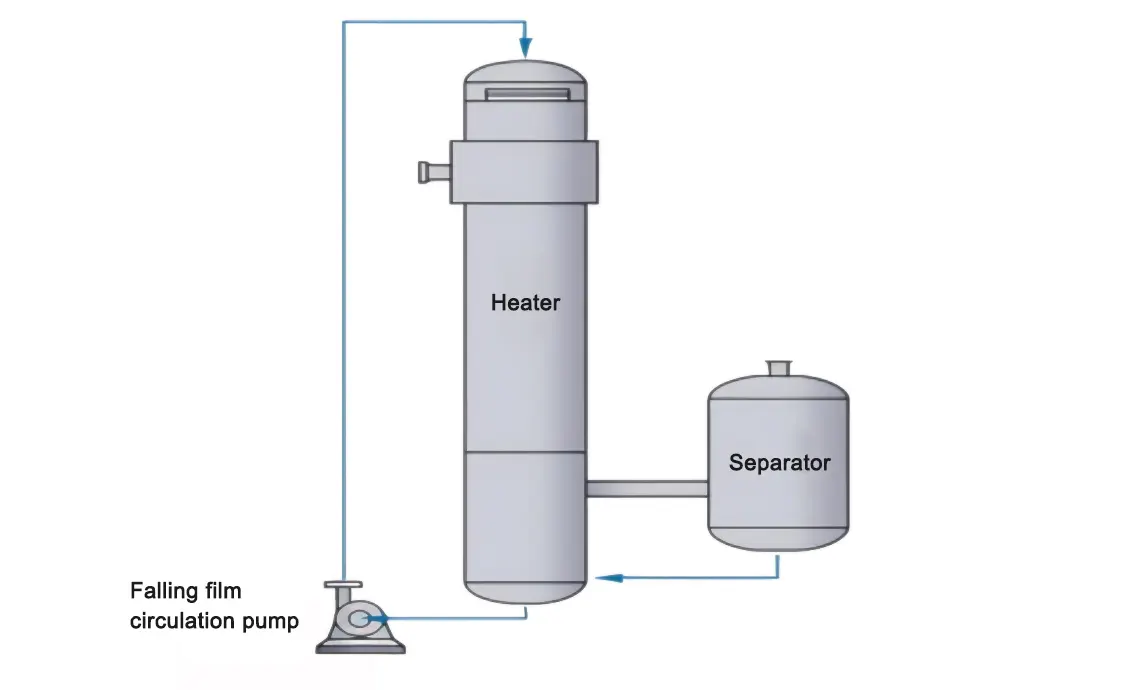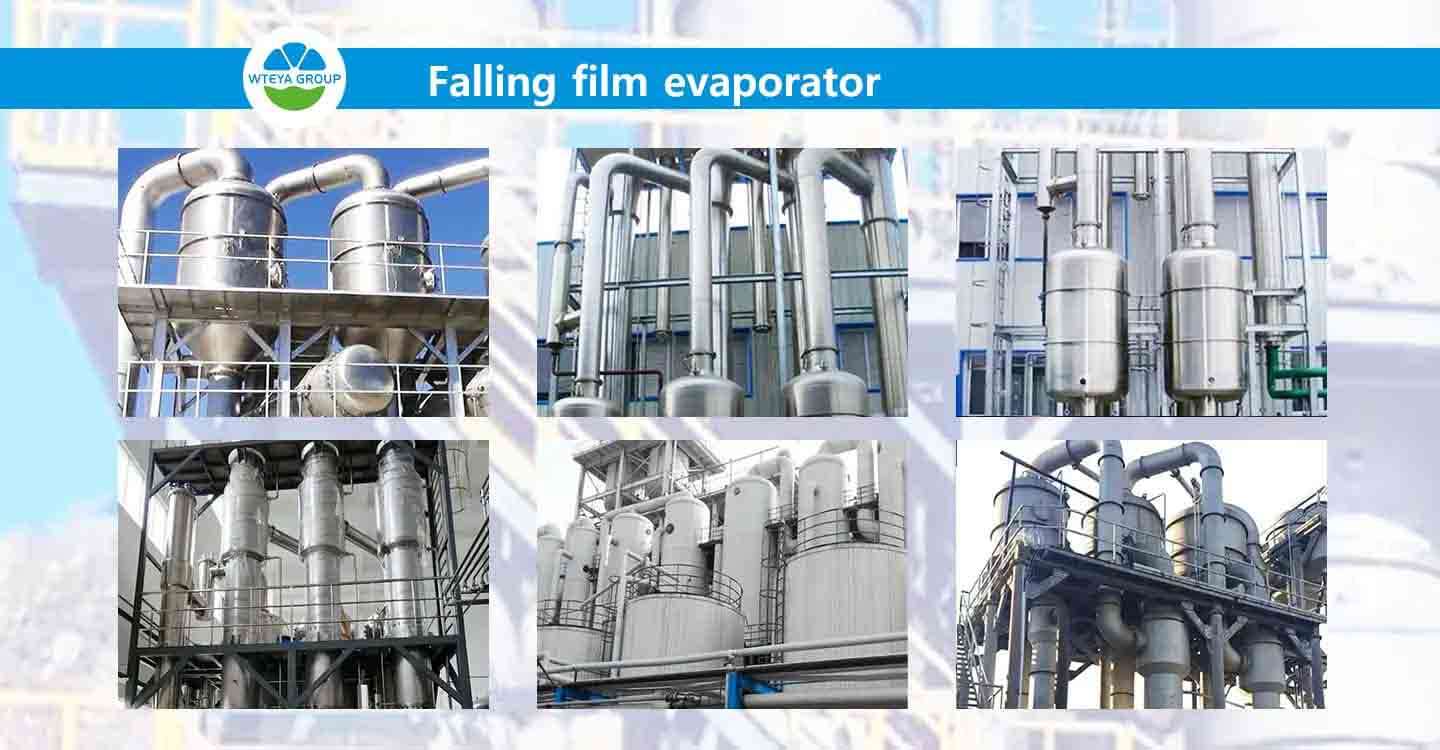Thin Film Evaporator
Menu
Latest News
Product introduction
Introduction to thin film evaporator
Thin film evaporator is an efficient evaporation equipment, mainly used in the liquid concentration process, especially suitable for the treatment of heat sensitive materials. The thin film evaporator can be simply understood as a set of film distributing device added to the vertical tubular heat exchanger, whose shell path is fixed to the heating fluid and tube path is fixed to the evaporated material. The material enters the heat exchange tube from the top of the tube and passes through the film distributor before entering the heat exchange tube, so that it is thin film when entering the heat exchange tube. In the process of material top-down, water is evaporated, so as to achieve the purpose of concentration.
Thin film evaporator composition
The scraper film evaporator is mainly composed of a heater, a separator, a preheater, a condenser, etc., and is equipped with a liquid distribution device, a feed liquid pump group and other auxiliary equipment.
All effect heater: It is the core part of the film scraper evaporator, which is used for heating and evaporating the liquid.
Each effect separator: used to separate the evaporated gas and liquid.
Preheater: used to preheat the raw material liquid to close to the boiling point to improve the evaporation efficiency.
Condenser: used to condense the evaporated steam into a liquid for subsequent treatment or recovery.
Liquid distribution device (film distributor) : to ensure that the material liquid is evenly distributed in the heating tube, forming a film-like flow, in order to facilitate efficient heat transfer and reduce the risk of scaling.
Feed liquid pump group: including each effective feed liquid pump, responsible for the transport and circulation of feed liquid.
Insulation pipe: used to maintain material temperature and prevent heat loss.
Vacuum and drainage system: used to maintain the negative pressure state in the system, excluding non-condensing gas and concentrated liquid.
Thin film evaporator features
1. High thermal efficiency: the material liquid flows in a film shape in the tube, increasing the heat transfer area, thereby improving the thermal efficiency.
2. Strong adaptability: Because the material in the tube is film-like flow, thin film evaporator is suitable for evaporation of high viscosity liquid.
3. Short heating time: The heating time of the material in the tube is short, which helps to preserve the nutrients of heat-sensitive materials such as food.
4. High operational flexibility: small liquid retention, can be quickly adjusted according to the feed amount, energy supply, vacuum and concentration changes.
5. Low temperature differential evaporation: the process fluid flows only under the action of gravity and can be evaporated at a lower temperature difference, reducing the risk of thermal decomposition.
6. Good safety: The equipment is basically operated under negative pressure and has good safety performance.
7. Large processing capacity: it can handle materials with higher concentration and higher viscosity.
8. Short residence time: not easy to cause material deterioration, suitable for handling heat-sensitive materials.
Application field of thin film evaporator
Film evaporator has a wide range of applications in the industrial field, especially in:
Food industry: For the concentration of dairy products, juices, honey and other foods, the scraper evaporator can evaporate at a lower temperature to retain the flavor and nutrition of the food.
Chemical industry: In the production process of chemical products, the scraper evaporator is used for solvent recovery, waste liquid treatment and chemical concentration.
Process flow

The process flow of the falling film evaporator mainly includes the following steps:
Liquid distribution: The raw liquid is pumped into the upper tube box of the heating chamber of the falling film evaporator, and then evenly distributed to each heat exchange tube through the liquid distribution and film forming device.
Film flow: Under the action of gravity, vacuum induction and airflow, the feed liquid forms a uniform liquid film on the inner wall of the heat exchange tube and flows from top to bottom.
Heating and vaporization: During the flow process, the feed liquid is heated and vaporized by the shell-side heating medium, and the generated steam and liquid phase enter the separation chamber of the evaporator together.
Gas-liquid separation: In the separation chamber, the steam and the concentrated liquid are separated, the concentrated liquid is discharged from the bottom, and the steam can be sent to the condenser for condensation or used as the heating medium of the next evaporator.
Technical principle of
The core principle of falling film evaporator technology is that the material liquid forms a film-like flow along the inner wall of the heating tube under the action of gravity and vacuum and is evaporated and concentrated. Its working process mainly includes the following steps:
Liquid distribution: The raw material liquid is evenly distributed on the inner wall of the heating tube through the liquid distribution device to form a thin liquid film.
Heat exchange: The inner wall is usually made of thermal conductive material, and the heat source provided by the outside increases the surface temperature of the inner wall to higher than the boiling point of the liquid, thus promoting the rapid heat transfer of the liquid to the tube wall and evaporation.
Evaporation and concentration: During the flow process, due to the existence of temperature difference, the liquid film evaporates rapidly on the tube wall and is converted into steam. At the same time, the solute substance is enriched in the remaining liquid to achieve the effect of concentration.
Gas-liquid separation: The generated vapor-liquid mixture enters the separation chamber from the bottom of the heating tube, and after the gas-liquid separation, the concentrated liquid is discharged from the bottom of the separator to complete the evaporation process.
Production of equipment

WTEYA aims to digital and intelligent production to provide superior products and services to its customers. We not only provide a wide range of standard products which are seriously tested and stable performance to meet a wide range of industrial needs. We also provide custom service, as well as OEM and ODM services, professional design team provides proper solutions for customers to meet their unique needs. We will work closely with each customer to ensure that every device suits customer's process requirements and production process accurately. WTEYA's one-stop service, innovative to create high-quality mechanical products and system solutions, professionally help customer deal with various water treatment problems.
Capacity and size
|
Falling film evaporation equipment parameter table |
|||||
|
Evaporation capacity(t/h) |
Evaporator type |
Gross power(KW/h) |
Steam consumption(t/h) |
Circulating water consumption(t/h) |
Floor area (L*W* H/m) |
|
6 |
Falling film circulating evaporator |
125 |
4.2 |
350 |
7*8*12 |
|
1 |
Falling film circulating evaporator |
13.2 |
1.1 |
80 |
3*3*10 |
|
2.5 |
Falling film circulating evaporator |
35 |
3 |
120 |
4*3*6 |
Frequently Asked Questions
Q: When the falling film evaporator runs, the liquid distribution is not uniform how to do?
A: This may be due to improper design or adjustment of the liquid distributor. The film distributor needs to be checked and adjusted to ensure that it distributes the liquid evenly on the wall of the heating tube.
Q: How to deal with the scaling problem of falling film evaporator heating pipe?
A: Regular cleaning of heating pipes is a common way to deal with scaling. According to the nature of the feed liquid, choose the appropriate cleaning agent and cleaning cycle to ensure the heat transfer effect of the heating tube.
Q: Is falling film evaporator suitable for handling high viscosity solution?
A: Yes, falling film evaporators are particularly suitable for handling high-viscosity solutions, because the material liquid forms a film-like flow on the inner wall of the heating tube, which is conducive to heat transfer and evaporation.
Q: If the raw material liquid contains solid particles, what will be the impact on the falling film evaporator?
A: The solid particles in the raw material liquid may cause wear on the inner wall of the heating pipe, and long-term operation may lead to pipe leakage. It is necessary to pretreat the heating tube to remove particles or select a wear-resistant material.
Q: How to control the concentration of the solution during the operation of the falling film evaporator?
A: By monitoring the temperature and amount of secondary steam, as well as the rate and concentration of liquid output, the operating parameters of the falling film evaporator can be adjusted to control the concentration of the solution.
Previous: No More
Next: No More







